( ESNUG 538 Item 7 ) -------------------------------------------- [04/04/14]
Subject: Why we switched from CDNS EDI/PT flow to MENT Olympus-SoC/PT flow
> From reader feedback, it appears the ICC II technical details my spies
> reported were very close, if not spot on. Aart's talk about "better
> throughput" and multi-CPU was clearly aimed at knocking down Atoptech.
>
> But, to be honest, my spies didn't predict the strong "floorplanning"
> spin SNPS put in the ICC II launch. On cue, Imagination/STmicro/LSI
> all gushed on how ICC II's super-fantabulous floorplanning sped their
> design process by 7X to 10X. That is, Aart is positioning ICC II to
> also attack Cadence EDI's First Encounter floorplanning franchise.
>
> - from http://www.deepchip.com/items/0538-01.html
From: [ The Lone Ranger ]
Hi, John,
Please keep me anonymous.
Good job on getting the scoop on ICC II so early before SNUG.
I can't speak about ICC use (because we're an ex-Cadence house), but I can
share why we switched from CDNS EDI to MENT Olympus-SoC.
---- ---- ---- ---- ---- ---- ----
FLOORPLANNING & PLACEMENT
Without being too specific, we design TSMC 40/28 nm, 320 Mhz, 1 M inst chips
that are a sea of analog cells and memory macros (40%) with std cells (60%)
densely placed in between. When we used CDNS EDI, it couldn't uniformly
distribute the std cells to minimize congestion nor meet our IR-drop specs.
Old flow
1. Cadence RC Compler
2. Cadence EDI PnR
3. Cadence QRC extraction
4. Synopsys PrimeTime and PrimeTime-SI
5. Apache VoltageStorm
New flow
1. Synopsys Design Compiler
2. Mentor Olympus-SoC
3. Mentor Calibre XACT-SoC
4. Synopsys PrimeTime and PrimeTime-SI
5. Apache VoltageStorm
We did hierarchical floorplanning inside Olympus-SoC, bottom up, where we
partitioned our design into four different blocks. We pre-placed all the
analog ports on the blocks and then assembled at top level for closure.
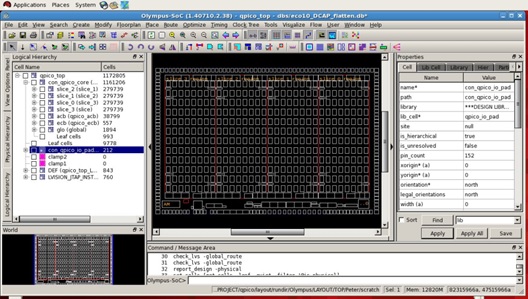 The initial Olympus-SoC placement got fairly good cell density. From what
we saw, it correlated well with the final congestion map after routing.
The initial Olympus-SoC placement got fairly good cell density. From what
we saw, it correlated well with the final congestion map after routing.
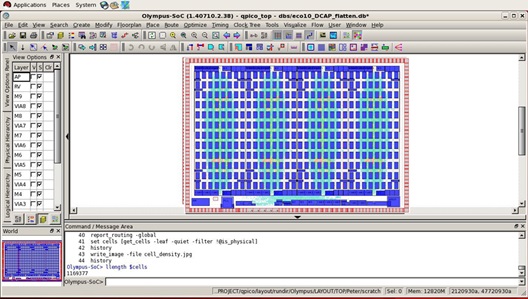
 We were happy to see the placer effectively utilize the area between our
macros and spread the cells to minimize congestion and IR drop issues.
---- ---- ---- ---- ---- ---- ----
OPTIMIZATION
Our design had 8 MCMM scenarios that we had to optimize for both timing and
power. With CDNS EDI we had trouble converging on timing with our 8 corners
enabled, and it took almost 4 weeks with 20 ECO runs.
With Olympus we did all 8 corner simultaneously. It concurrently optimized
for timing, SI, and power across all 8 scenarios. We closed in 6 days with
7 ECO iterations.
Olympus-SoC> update_timing
info TA_CMDS6300: Running Multi-Core Timing Analysis using 6 CPUs.
warning TA_CMDS58: There is no enabled design mode for corner
'func_ss_tn40_v108_cw_setup'. Please disable it, otherwise
timing could be inaccurate.
warning TA_CMDS2503: Path group outputs does not exist. Can not modify.
warning TA_CMDS54: There is no max library defined for corner
'func_ss_tn40_v108_cw_setup'.
warning TA_CMDS55: There is no min library defined for corner
'func_ss_tn40_v108_cw_setup'.
info extr538: The corner func_ss_t125_v108_cw_setup check passed!
info extr538: The corner func_ss_t125_v108_cw_hold check passed!
info extr538: The corner func_ss_tn40_v108_rcw_setup check passed!
info extr538: The corner func_ss_tn40_v108_rcw_hold check passed!
info extr538: The corner func_ff_t0_v132_cb_setup check passed!
info extr538: The corner func_ff_t0_v132_cb_hold check passed!
info extr538: The corner func_ss_tn40_v108_cw_setup check passed!
info extr540: The Extraction Technology Check Passed!
info UI33: performed update timing for 41 minutes 28 seconds
(CPU time: 2 hours 46 minutes 0 seconds, current memory usage: 20387 M)
Olympus-SoC MCMM Variability Report
Olympus-SoC> report_var
info UI33: performed update timing for 0 seconds
(CPU time: 0 seconds, current memory usage: 20387 M)
------------------------------------------------------------------------
| MCMM variability report for design 'happy_top' (nano) |
|----------------------------------------------------------------------|
| | WNS TNS #Endpts WHS THS #Endpts |
|----------------------------------------------------------------------|
| **global** | -0.505 -300.6 2953 -0.813 -235.6 3891 |
| ss_t125_v108_cw_setup | -0.472 -126.8 1804 -ne- -ne- -ne- |
| ss_t125_v108_cw_hold | -ne- -ne- -ne- -0.785 -108.4 255 |
| ss_tn40_v108_rcw_setup | -0.505 -217.8 1599 -ne- -ne- -ne- |
| ss_tn40_v108_rcw_hold | -ne- -ne- -ne- -0.813 -103.8 265 |
| ff_t0_v132_cb_setup | 0.000 0.000 0 -ne- -ne- -ne- |
| ff_t0_v132_cb_hold | -ne- -ne- -ne- -0.533 -213.9 3891 |
------------------------------------------------------------------------
Since they're both MENT tools, we weren't surprised that Olympus-SoC numbers
correlated very well with Calibre XACT-SoC. It also correlated well with
PrimeTime and PrimeTime-SI.
---- ---- ---- ---- ---- ---- ----
ROUTING
Both the analog cells and memories (which took up 40% of our design) used
Metal1 through Metal4. Our power mesh also took up significant resources
due to our stringent IR-drop requirements. Our EDI flow had a lot of
congestion due to these limited routing resources and poor correlation
between the global and detailed routing engines. We had a higher number
of DRCs leading to longer ECO cycles.
The Olympus router closed using the available resources. Its GR-based
congestion estimates were consistent before and after routing. We used a
bottom up approach and routed our analog contacts first (Metal6-9) and
created a DEF file. Locked the analog contact route positions and used
the remaining space to route our std cell logic using Metal1 to Metal9.
---- ---- ---- ---- ---- ---- ----
DRC/LVS/SIGN-OFF
Our EDI physical verification sign off cycle was painful due to multiple
iterations between EDI and PrimeTime to detect and fix DRC issues. This
was caused because of a miscorrelation between the outdated router
technology rule files and the SVRF deck used by the signoff tools.
We were happy to see the placer effectively utilize the area between our
macros and spread the cells to minimize congestion and IR drop issues.
---- ---- ---- ---- ---- ---- ----
OPTIMIZATION
Our design had 8 MCMM scenarios that we had to optimize for both timing and
power. With CDNS EDI we had trouble converging on timing with our 8 corners
enabled, and it took almost 4 weeks with 20 ECO runs.
With Olympus we did all 8 corner simultaneously. It concurrently optimized
for timing, SI, and power across all 8 scenarios. We closed in 6 days with
7 ECO iterations.
Olympus-SoC> update_timing
info TA_CMDS6300: Running Multi-Core Timing Analysis using 6 CPUs.
warning TA_CMDS58: There is no enabled design mode for corner
'func_ss_tn40_v108_cw_setup'. Please disable it, otherwise
timing could be inaccurate.
warning TA_CMDS2503: Path group outputs does not exist. Can not modify.
warning TA_CMDS54: There is no max library defined for corner
'func_ss_tn40_v108_cw_setup'.
warning TA_CMDS55: There is no min library defined for corner
'func_ss_tn40_v108_cw_setup'.
info extr538: The corner func_ss_t125_v108_cw_setup check passed!
info extr538: The corner func_ss_t125_v108_cw_hold check passed!
info extr538: The corner func_ss_tn40_v108_rcw_setup check passed!
info extr538: The corner func_ss_tn40_v108_rcw_hold check passed!
info extr538: The corner func_ff_t0_v132_cb_setup check passed!
info extr538: The corner func_ff_t0_v132_cb_hold check passed!
info extr538: The corner func_ss_tn40_v108_cw_setup check passed!
info extr540: The Extraction Technology Check Passed!
info UI33: performed update timing for 41 minutes 28 seconds
(CPU time: 2 hours 46 minutes 0 seconds, current memory usage: 20387 M)
Olympus-SoC MCMM Variability Report
Olympus-SoC> report_var
info UI33: performed update timing for 0 seconds
(CPU time: 0 seconds, current memory usage: 20387 M)
------------------------------------------------------------------------
| MCMM variability report for design 'happy_top' (nano) |
|----------------------------------------------------------------------|
| | WNS TNS #Endpts WHS THS #Endpts |
|----------------------------------------------------------------------|
| **global** | -0.505 -300.6 2953 -0.813 -235.6 3891 |
| ss_t125_v108_cw_setup | -0.472 -126.8 1804 -ne- -ne- -ne- |
| ss_t125_v108_cw_hold | -ne- -ne- -ne- -0.785 -108.4 255 |
| ss_tn40_v108_rcw_setup | -0.505 -217.8 1599 -ne- -ne- -ne- |
| ss_tn40_v108_rcw_hold | -ne- -ne- -ne- -0.813 -103.8 265 |
| ff_t0_v132_cb_setup | 0.000 0.000 0 -ne- -ne- -ne- |
| ff_t0_v132_cb_hold | -ne- -ne- -ne- -0.533 -213.9 3891 |
------------------------------------------------------------------------
Since they're both MENT tools, we weren't surprised that Olympus-SoC numbers
correlated very well with Calibre XACT-SoC. It also correlated well with
PrimeTime and PrimeTime-SI.
---- ---- ---- ---- ---- ---- ----
ROUTING
Both the analog cells and memories (which took up 40% of our design) used
Metal1 through Metal4. Our power mesh also took up significant resources
due to our stringent IR-drop requirements. Our EDI flow had a lot of
congestion due to these limited routing resources and poor correlation
between the global and detailed routing engines. We had a higher number
of DRCs leading to longer ECO cycles.
The Olympus router closed using the available resources. Its GR-based
congestion estimates were consistent before and after routing. We used a
bottom up approach and routed our analog contacts first (Metal6-9) and
created a DEF file. Locked the analog contact route positions and used
the remaining space to route our std cell logic using Metal1 to Metal9.
---- ---- ---- ---- ---- ---- ----
DRC/LVS/SIGN-OFF
Our EDI physical verification sign off cycle was painful due to multiple
iterations between EDI and PrimeTime to detect and fix DRC issues. This
was caused because of a miscorrelation between the outdated router
technology rule files and the SVRF deck used by the signoff tools.
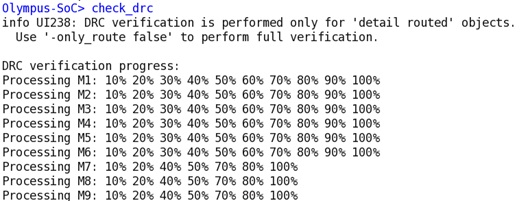
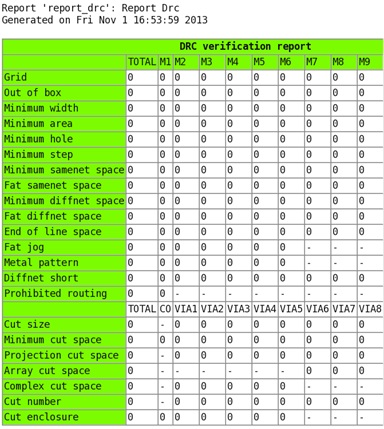
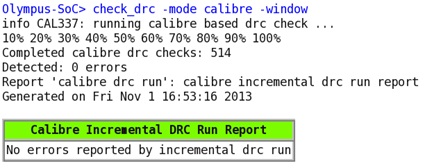 With Olympus we used Calibre sign-off and SVRF decks directly inside P&R
with InRoute. Since these had 100% correlation, we essentially eliminated
our physical verification ECO cycle.
We strongly believe this tight integration between Olympus and Calibre will
help in our future projects, especially for smaller nodes.
---- ---- ---- ---- ---- ---- ----
MENT FIX THIS
- We found that the Olympus floorplanning usability and GUI to be
lagging behind and needs improvement. We were using the older
version of Olympus and were able to work around some of these
issues.
- We have been told the latest Olympus release has an enhanced
floorplanner. We hope it'll address our usability concerns.
Overall we were happy that Olympus closed our unique designs and it is the
plan of record for our upcoming projects. Needless to say we are happy with
the Olympus-SoC tool and the support MENT gives for it.
- [ The Lone Ranger ]
With Olympus we used Calibre sign-off and SVRF decks directly inside P&R
with InRoute. Since these had 100% correlation, we essentially eliminated
our physical verification ECO cycle.
We strongly believe this tight integration between Olympus and Calibre will
help in our future projects, especially for smaller nodes.
---- ---- ---- ---- ---- ---- ----
MENT FIX THIS
- We found that the Olympus floorplanning usability and GUI to be
lagging behind and needs improvement. We were using the older
version of Olympus and were able to work around some of these
issues.
- We have been told the latest Olympus release has an enhanced
floorplanner. We hope it'll address our usability concerns.
Overall we were happy that Olympus closed our unique designs and it is the
plan of record for our upcoming projects. Needless to say we are happy with
the Olympus-SoC tool and the support MENT gives for it.
- [ The Lone Ranger ]
Join
Index
Next->Item
|
|



